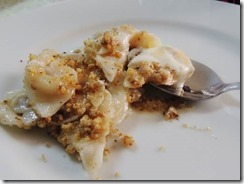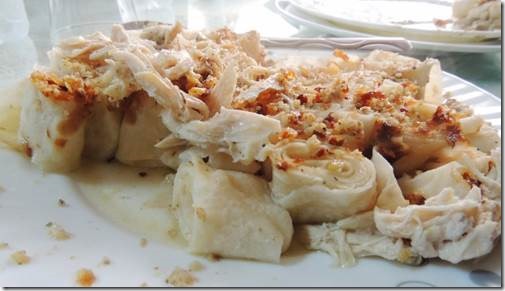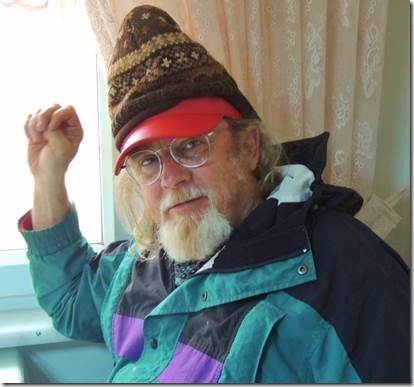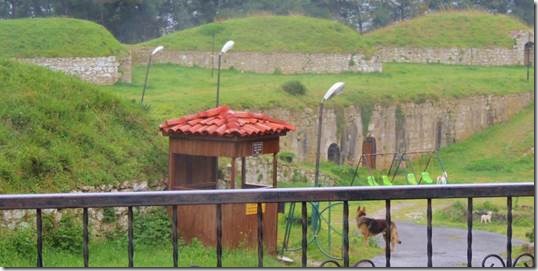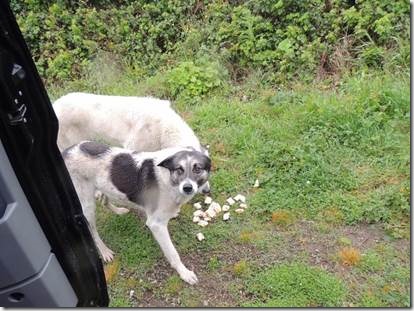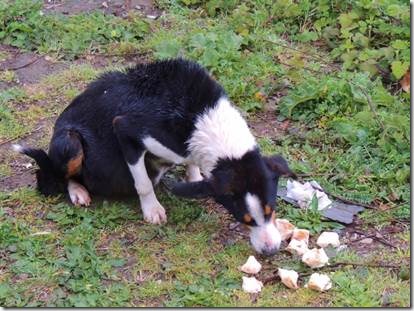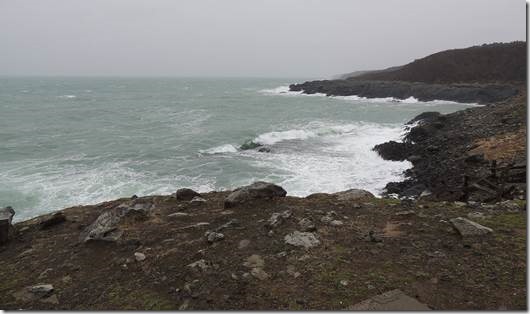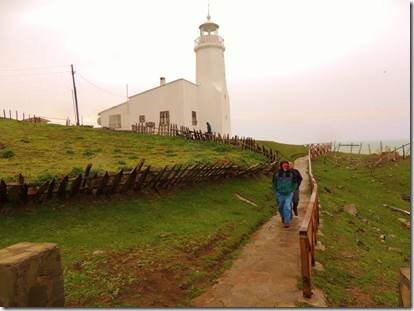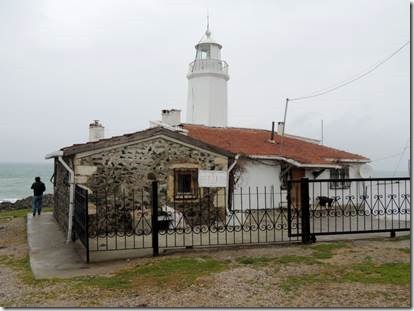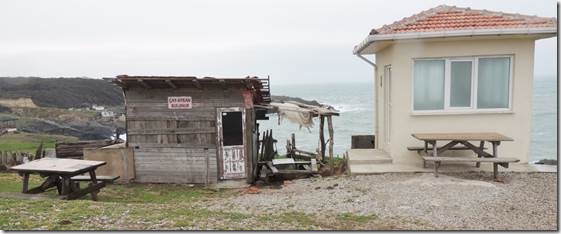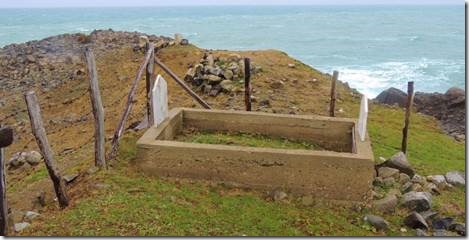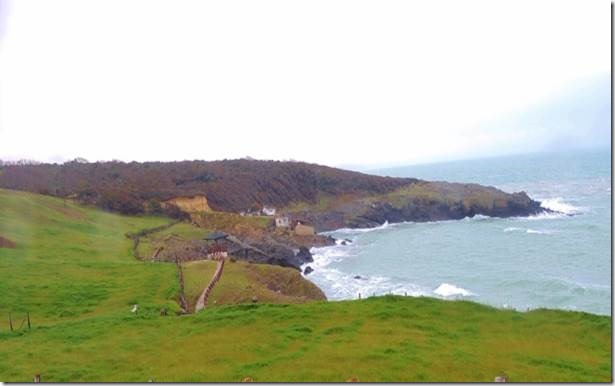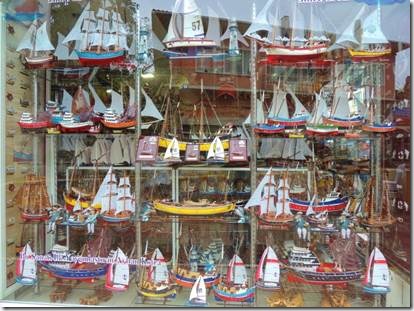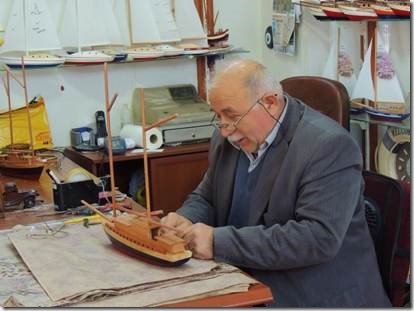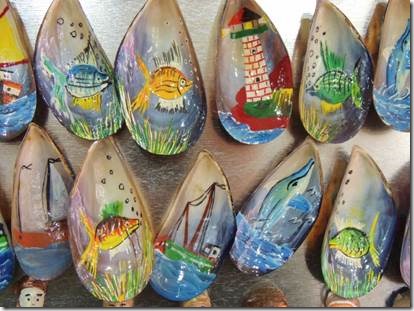Merhaba,
Done is better than good, so here is Sinop part 2 such as it is.
Ru
Sinop part 2
Another perspective about the nuclear power plant to be built in Sinop….
“But now, a plan by Istanbul’s powerful Anadolu Group to build a 1,200 MW coal-fired power plant in Gerze, a town 25 km east of Sinop, and the government’s aim to build a nuclear power plant at Inceburun, have Mr. Ergul and tens of thousands of citizens roiled. "The power plants will turn our tourism paradise city into hell," he says. "No one has the right to put hell inside paradise."
The entire interview with Sinop’s Mayor Ergul is at the end of the email.
|
This was the bit of manti I stole from Randal’s plate while waiting for my “chicken wrap.” “We’re manti (Turkish ‘ravioli’) lovers from way back, so when Mert told us about the local version made with walnuts we made straight for his recommended source. Imagine a huge plate of minced lamb-stuffed ravioli (small portions are not found, it seems, in your average Turkish restaurant) tossed in soupspoon fulls of rich freshly churned butter. Add handfuls of crushed walnuts so fresh that they’re fairly oozing oil. This meal, our last in Sinop before we hit the road for Kastamonu, nearly put us over the top. But it was well worth the physical discomfort.” http://eatingasia.typepad.com/eatingasia/2011/01/sinop-turkey-off-season-specialties-nokul-cevizli-mantisi.html which is a great site for learning about food and travel in Turkey. We also went to Kastamonu so you’ll read about that from me later. Unfortunately I can’t find any info about my luscious dish, a sort of chicken wrap. Half of us ordered the manti and half the “chicken wrap.” This was very different from the chicken wrap we’re used to but it was great. Light dough was rolled with bits of chicken, and walnuts, and there was chicken broth in the plate just to keep it all moist. I ate about 1/3 of mine and the rest was boxed up for the stray dog and several folks did the same. If we’d known how huge the portions were going to be, we would have shared though Randal wanted manti and I wanted the wrap. But the prices were unbeatable, and when you see the photos of the happy dogs, it was worth having the extra food for them. |
|
Randal looks like some kind of strange dervish. It was definitely chilly enough for 2 hats (his red, my brown) until the heater behind us was turned on and we warmed up. I’m not sure he ever took off his jacket or scarf. |
|
After lunch, because of the icky weather, plans changed from more walking around town or a boat trip along the coast. Taṣ suggested that we take a drive along the coast to Ince Burunu (Thin Nose) or Cape Ince, the northernmost point of Turkey. Ayden left the restaurant to get our mini-bus parked at the fortification lot at the edge of town. I jumped up and told Randal I was walking with Ayden, but Randal came too and so did Patricia. As we’d all told each other and not someone who was actually remaining at the restaurant, Ayden got a call from Taṣ checking if we were with him. Our bad for not telling Taṣ, but he’s so easy going, so no problem. And the walk after the meal felt good, even in the drizzle. |
|
Taṣ walked in to check out the WW 1 bunkers, but this shepherd escorted him out; in a hurry. Most dogs are very friendly, but this one had a job to do. |
|
Dogs we fed our left over lunch food. This one had recently had puppies. The dogs look healthy enough, but it’s still sad that they have no homes. |
|
Inceburun The Black Sea “JOURNEY TO THE FAR NORTH One of the most interesting spots at Sinop is the lighthouse that stands at the northern tip of the country. Some 22 kilometers from the city center, the lighthouse can be reached by following the signs that say, ‘See Turkey’s northernmost point’. Settlement thins out significantly in the last five kilometers, giving way to pastoral landscapes. Green hills and herds of goats surrounded by wooden fences and a sense of solitude as far as the eye can see will accompany you all along the way as you wind down to the shore where a spectacular view awaits you at the end of the road: basalt rocks pounded by tempestuous waves and rising immediately above them the slim elegance of İnceburun Lighthouse, guardian angel of the local people who have made their living from the sea for centuries.” http://www.turkishairlines.com/en-int/skylife/2009/october/articles/sinop.aspx |
|
Sinop Light (Ince Burun) was built in 1863. 1863. Active; focal plane 26 m (85 ft); four white flashes every 20 s. 12 m (39 ft) masonry tower with lantern and gallery, attached to a 1-story masonry keeper’s house. The upper portion of the tower is octagonal and the lower portion is square. Entire lighthouse painted white. Three additional keeper’s houses or other light station buildings. http://www.unc.edu/~rowlett/lighthouse/tur1.htm |
|
I don’t know if these are the other keeper’s houses; I just raced around the landscape wanting to hike off in all directions. |
|
The sign says Tea and Ayran available here….once upon a time |
|
A lovely place to spend forever… |
|
“If we had but world enough and time.” I’d have hiked the path that follows the coast. (“Poem of the week: To His Coy Mistress Marvell’s great poem manages to be serious and light, epic and personal, as aware of the pleasures of the flesh as the transience of life.” |
|
All too soon it was time to return to Sinop and time to “do your own thing.” Some folks returned to the hotel, but several of us wanted to visit Sinop center and see the model ship shops. We would have an hour to tour around. We started as a group, but then somehow I lost everyone which was fine; we all had our own agendas. I wanted some covered elastic bands for my hair. Not very exotic except when you have to do it in another language. By the time I’d found a shop selling this and that and covered elastic bands, I’d lost everyone else. No problem. I had my phone, my money and I knew where we’d meet up. |
|
Hello Everyone, My name is Ayhan Demir. I was born in Sinop in 1950. I have developed this art inspired by the man called the ‘Master’ then serving a sentence in Sinop Prison. The master then got out of the prison and opened a small workshop to produce small models. He used to sell these models at the harbour. I was very impressed by a model that I saw in his workshop and decided to improve this art. I was continuing my education at the Art School opened in Sinop in 1950 when I started production at home. I was selling my models to the boat passengers to pay for my tuition. My carelessness caused me to lose my right small finger to the cutting machine. After my graduation at 15, I opened a small shop to build model ships. These models got the attention of American officers working in the American Radar Station during 1952 (this date can’t be correct, the base wasn’t open then, so maybe 1972) in Sinop, my ships were known in the States because of the officers working in Turkey. During those years I guess I sold around 8, 000 models to America. If you add all the models I have made during the 50+ years end to end, it would reach from Sinop to Istanbul (nearly 630 km) In years, Sinop found its place in Turkish tourism and this art of modelling remained a symbol of this beautiful city. This subject found its way in the written and visual media, I have great pride in introducing this art to my city. I have trained my son from his youth for modelling and he is going to take the flag from me to carry us further. The material I use in my models is 2mm over the walnut trees. We use auto paints to give color as desired. Each model is made by hand and takes a lot of time http://www.tradekey.com/product-free/Model-Fishing-Boat-947634.html I don’t know if this story is true or not. I’ve read other blogs that say prisoners started the model culture in Sinop. And there is a Turkish-American Radar Base in Sinop. |
|
This fellow might or might not be Ayhan Demir, but he is making models in Sinop and he could be 62. Too bad we can’t see his right hand to check for the missing finger. |
|
I would have bought the one with the green boat, but we have no place to put a magnet in the boat and there was no clerk in the shop anyway. |
|
I really wasn’t so interested in buying any boat model souvenirs so I just took a walk over to the harbor and then around town. I bought some Coke Zero and some snacks to take back to our room; dinner was at 7:30 and my huge lunch was actually wearing off. Then I took myself off to the meeting spot and along came the van, full of everyone else. They had run into Taṣ and Ayden a bit earlier. |
|
I have spent way too long making myself crazy trying to find the exact name of my lunch dish; if Ayhan Demir is a real person, and the date the Radar Station opened/closed in Sinop. Researching with only Google is just not good enough. But I found some interesting bits of information; at least interesting to me. They’re at the end so you can skip them if you want. “….an American Cold War intelligence-gathering radar base that provided most of the civilian jobs of the city. Mr. Ergul’s father worked as a handyman at the base, which shuttered in 1992.” http://www.dunya.com/power-plants-will-turn-sinops-paradise-into-hell-mayor-179321h.htm Sinop ‘The Hill’ (closed) Former Sinop TUSLOG Det (1957-1993) manned up a US radar station and listening post a.k.a.Diogenes Station or "the Hill" to monitor the USSR. http://wikimapia.org/24902390/Sinop-The-Hill-closed |
|
http://www.goturkey.com/images/brochure/pdf/sinop_eng.pdf guide to Sinop to read before you go. |
|
Sinop, Turkey – The Lonely Life On The Hill (from the June 1973 edition of The Hallmark) Courtesy of Dave Shively ——————————————————————————– ——————————————————————————– In the fall and winter bone-numbing winds lash the Turkish-American radar site that stands like a beacon high above the ancient Black Sea port of Sinop, Turkey."The Hill," as it is known to the changing contingents of troops stationed here, was created centuries before the arrival of man – the product of a geologic convulsion that left a slender promontory jutting into the sea.Although a thriving Greek settlement at the time of Diogenes,the salty iconoclast born there during the fourth century B.C., the city today is on the remote fringe of NATO’s southeastern flank. The physical ruggedness of the site, and its off-the-beaten track location 900 feet above the sea, leave impressions that men who work here carry with them the rest of their lives. "They tell me you always remember a tour on ‘The Hill.’ After a winter here I know why. The wind howls incessantly. Half the time we’re squatting in a cloud bank. When it snows the flakes fly horizontally," said a junior officer who has developed an appreciation for the neat, snug little base and the rough-hewn beauty of the surrounding terrain. "In the summer it’s quite pleasant. On a clear night we see the lights of Sinop twinkling below us." Not everyone shares his enthusiasm, but a surprising number of men seem to be philosophical about a tour at Sinop and many acquire a strange fascination for the assignment, once they become accustomed to the isolation and the unusual setting. The remoteness is something that is sensed from the day the new arrival flies into the Black Sea port of Samsun aboard a two-engine Turkish Airlines (THY) plane. From Samsun he has time to savor the rugged beauty of the coastal terrain, as he rides the base bus on the lone road to Sinop,a rough and winding three-hour trip on a route that never strays far from the sea. To make up for the isolation, the base has been equipped with many of the amenities found back home. During the summer, Ataturk Field is lighted for evening baseball and softball.The gymnasium, handball courts, bowling alleys and steam bath are open year round. For men who wish to indulge in pursuits of the mind, the education office schedules university and high school courses and the library offers 10,000 volumes – a larger selection than normal for a base the size of Sinop. The biweekly newspaper, "The Diogenes," (handset by Turkish printers who do not read English) chronicles on-base and off-base activities. The theatre, now receiving the latest movies from the Armed Forces Motion Picture Service, is one of the most popular places on base. Regularly scheduled chapel tours are run to Trabazon, an ancient community on the Black Sea, and to Izmir, the historic city on the Aegean. The "White Boat," a Turkish cruise ship that travels between Sinop and Istanbul twice a week, is particularly inviting to men on "The Hill," with its reasonable $25 round-trip tab for military personnel. Most men on leave take the bus as far as Samsun, where they book flights on THY to Ankara, Istanbul and Europe.During the one-year tour many personnel manage to make at least one trip home via chartered air – round-trip fare that usually runs less than $250. Two four-place U8 aircraft maintained at a nearby field are used for limited runs to Samsun and Istanbul.In Sinop, a city of 16,000, the Yeni (New) Hotel restaurant is a popular rendezvous for Americans who order donner kebab, roast lamb built up from thin layers on a thick spike. Next to eating, souvenir hunting in Sinop shops and boar hunting in the region around Sinop are favored diversions. But it was Diogenes, born about 320 B.C., who put Sinop on the map with his wit and showmanship, the most famous act being his search with a lantern in broad daylight for an honest man. It gets lonely. Only a handful of servicemen, (204), are assigned to the site from TUSLOG, Det 4. One hundred and sixty nine live off post and most of them do so because they paid to transport their families overseas. Because there are no family quarters and no dependent school on base, a tour to Sinop is unaccompanied. As a result, servicemen who choose to be accompanied must pay their wives’ transportation from the United States. Most men consider the separation from their homes and their families the most undesirable aspect of duty on "The Hill." "It wouldn’t be bad at all if we could have our families with us," said a junior NCO. "It’s okay. You eventually get used to it. But the winter really drags. Especially during the bad weather, when the roads become a quagmire, and we don’t get mail for a week," said a single soldier with a girlfriend back home. Army Lieutenant Colonel C.D. Crowell, former commanding officer of TUSLOG, Det 4 and installation commander, urges men to get off "The Hill" as often as possible. "The biggest problem here is providing something for the individual to do when he’s off duty," another officer said. Summer is the most pleasant season in Sinop and it’s during summer that most men take leave for travel in Turkey and Europe. The base bus, departing daily at 5:30 a.m., offers the quickest link toEurope via Turkish Airlines at Samsun. Throughout the 120 miles it’s a thrilling ride along the rugged coast where birds of prey soar from steep cliffs. Conspicuous by their absence are the resort hotels which now mark similar coastal regions across much of the globe. Reactions vary. Going to or coming from Sinop, individuals’ reactions run the gamut. Although his outlook is hardly typical, Specialist 5 Philip B. Bird, en route to Atlanta to visit his pregnant wife, offered an appraisal of his tour at Sinop which may be food for thought. "Duty on the Hill isn’t bad at all. I’ve traveled to a number of small towns in the vicinity of Sinop and I’ve grown very fond of the Turkish people," Bird said. "In the summer there are plenty of things to occupy your off-duty time. The beach rented by Special Services on the isthmus is delightful." "A lot of guys complain. But a tour on the Hill makes them learn to live by themselves. In this sense an assignment such as this helps them grow up." Reality check from Dave Shively: Handball courts = 1 Bowling alleys = 2 lanes Steam bath = 0 Library = 0 Newspaper = 0 Modern movies = Mary Poppins; Chitty-Chitty-Bang-Bang; etc. 169 living off base = maybe 5 Taking a trip home = ???????? Diner at the hotel restaurant = only available Saturday night I’ve never seen such a bunch of caca del toro in my life! – Dave Shively |
|
Sinop (Dunya) – Since he was elected mayor of this Black Sea coastal city in 2009, Baki Ergul, 60, a civil engineer and town boy, has done his utmost to transform his financially ailing municipality into a tourism mecca with the limited financial resources available. "We inherited a TL 35 million debt. The city had neither a real drinking water system nor a sewage network. There was no zoning plan for the municipality," Mr. Ergul, mayor of Sinop, Turkey’s northernmost city, recalled in an interview. "The ship was sunk. We have refloated it." Founded in 7th century A resort city of 50,000 inhabitants that balloons to 200,000 during the summer months, Sinop is located on a narrow peninsula and faces the Black Sea on both sides. Turkey’s northernmost point, Inceburun (Cape Ince), is only 30 km to the northwest. The city, which has an airport, is located 697 km east of Istanbul and 434 km, northeast of Ankara. Founded in the 7th century BC as a Greek colony of the ancient city of Miletus, Sinop is a major fishing port with hundreds of fishing boats docked in its boat shelter and marina. It is also a port of call for liners touring the Black Sea. The town has a prison that once held the country’s leading political prisoners, including the novelist Sabahattin Ali (1907-1948), but which has since been turned into a museum. Sinop is best known as the birth place of Diogenes (412 BC- 323BC), the ancient Greek philosopher and founder of the School of Cynicism. A statue of Diogenes with a lantern can be seen in the center of town. The city was also the birthplace of Necmettin Erbakan (1925-2011), Turkey’s first Islamist Prime Minister. City upgraded In a short span, Mr. Ergul, began building a new drinking water system for the city, started constructing a sewage system and preparing a new zoning plan for the city drawn, using his old ties as a former regional manager of the State Hydraulics Works Administration (DSI). Much of the financing for the projects have come from donations of companies that did work for Mr. Ergul at DSI, and from wealthy donors in the city, as well as municipal taxes and other revenues. "The municipality is paying TL 5 million to TL 6 million a month to pay off its debts," says Mr. Ergul, a Gene Kelly lookalike, in the interview in the municipal park, facing the city’s 7th century B.C. castle that was revamped by the Romans, the Byzantines and the Turks. The new TL 26 million drinking water system for the city is expected to be completed at the end of this year. Work is continuing on a new pre-treatment sewage system that will be completed in 2013, and a zoning plan for the city is expected to be finished next month, he says. Additionally, a new covered vegetable market place is in the works. New parks, with outdoor cafes and tea houses, have been constructed. Some 5 km of roads in the city have been paved. Thermal power plant But now, a plan by Istanbul’s powerful Anadolu Group to build a 1,200 MW coal-fired power plant in Gerze, a town 25 km east of Sinop, and the government’s aim to build a nuclear power plant at Inceburun, have Mr. Ergul and tens of thousands of citizens roiled. "The power plants will turn our tourism paradise city into hell," he says. "No one has the right to put hell inside paradise." Air and water pollution from the coal-fired site, he says, will devastate Sinop and the surrounding areas, and destroy fish feeding and breeding grounds along the coast. He also warned that the plant could be a cause of acid rain that could ruin the nearby Plains of Bafra, a major a farming area with wetlands where the Kizilirmak, Turkey’s longest river, empties into the Black Sea. The Plains of Bafra are located only 50 km east of Sinop, in the neighboring Samsun province. "The power plant will finish off the plains of Bafra and the wilderness country around Sinop," he says. He believes tourism is the only hope for Sinop after the closure 20 years ago of a major glass factory and an American Cold War intelligence-gathering radar base that provided most of the civilian jobs of the city. Mr. Ergul’s father worked as a handyman at the base, which shuttered in 1992. But he says new hotels have to be built. "If 20 tourist buses were come to Sinop, I would have trouble finding accommodations for all the guests," he stressed.” http://www.dunya.com/power-plants-will-turn-sinops-paradise-into-hell-mayor-179321h.htm |

